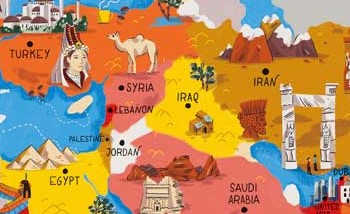The decision to exclude Israel from a book about Middle Eastern women is notable when considering the fact that most Israelis have deep roots in the region.
By Lauren Marcus, World Israel News
A new children’s book published in the U.K. is facing criticism for a cover which displays a colorful map of the Middle East – sans Israel, which is clearly labeled as Palestine.
The book, titled “Amazing Women of the Middle East: 25 Stories from Ancient Times to Present Day,” aims to educate children about achievements by women in the region.
But the clear exclusion of Israel has drawn ire from British NGO U.K. Lawyers for Israel (UKLFI), who said in a statement that the Pikku Publishing house responsible for the tome should amend the cover to include Israel.
Because the book is listed under “Educational resources” on Pikku’s website, UKFLI pressed the U.K.’s Education Ministry not to use the book in classrooms, as it promotes an inaccurate and biased narrative about the Middle East.
The decision to exclude Israel from a book about Middle Eastern women is notable when considering the fact that most Israelis have deep roots in the region.
The majority of Israeli Jews (53 percent) are of either full of partial Mizrahi descent, meaning that their families immigrated to Israel from Arab or Muslim countries.
For example, the late Israeli singer Ofra Haza, whose music is internationally acclaimed, sang at times in the Yemeni dialect of her parents and was proud of her Middle Eastern cultural heritage.
“This is a very attractive book, and it is a great idea for children to read about amazing women of the Middle East,” said UKLFI director Caroline Turner.
“However, to have excluded Israel from the map of the Middle East, and to have excluded all Israeli and Jewish women from the book is misleading and biased, and tends to promote a view of the Middle East that completely delegitimizes Israel.”
Pikku Publishing isn’t the first mainstream company to erase Israel from regional maps, or choose to use Palestinan place names rather than the modern Hebrew names.
Google Maps prominently displays the names of former Palestinian localities depopulated during Israel’s 1948 War of Independence alongside the names of neighborhoods and cities in present day Israel, World Israel News found in October 2021.
When using the mobile app Google Maps to view the central Israel city of Or Yehuda, for example, one can see the names of neighborhoods within the modern-day city, such as Kiryat Giora and HaHistadrut, displayed in grey, upper case letters.
However, “Kafar ‘Ana” is also displayed in the same font and styling, with no indication that the area has been part of Or Yehuda for more than 70 years.
It’s unclear why Google would choose to display the name of the village, which was peacefully evacuated in 1948 and had at its peak some 3,000 residents, as though it is a current neighborhood in an Israeli city which has a population of some 37,000 people today.


